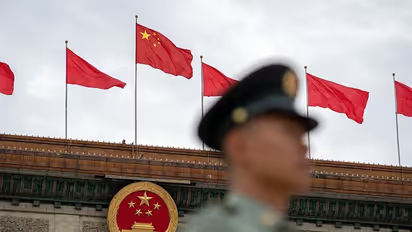Explained: Why Bhutan now wants China on the Doklam table with India

Synopsis
India has been opposing China's intrusion in Doklam since its close proximity to the strategically sensitive Siliguri corridor. It is a narrow tract of road that connects Northeastern states with the rest of India.
Bhutanese Prime Minister Lotay Tshering's recent statement that China has an equal say in resolving the Doklam plateau dispute has compounded India's worries. His statement came two months after the diplomats from China and Bhutan held talks on border settlement in the Chinese city of Kunming.
Explained: Why depleted uranium entering Ukraine war is dangerous
Tshering's recent statement contradicts what he had said in 2019 that neither side should do anything "unilaterally" at the existing tri-junction point, called Batang La. It is that point which separates India, Bhutan and China (Tibet). India's Sikkim is situated west of Batang La, China’s Chumbi Valley lies to the North, and Bhutan, to the South and East.
Why does India oppose China's intrusion in Doklam?
India has been opposing China's intrusion in Doklam since its close proximity to the strategically sensitive Siliguri corridor. It is a narrow tract of road that connects Northeastern states with the rest of India.
In 2017, troops of the Indian Army and China’s PLA had engaged in a faceoff for 73 days after New Delhi objected to Beijing's illegal construction of a road towards Jampheri ridge. China wants control over Jampheri ridge to keep a tab on India's sensitive Siliguri corridor or Chicken Neck, which is just 17 km away.
Why did the Bhutanese prime minister make a contrary remark on the Doklam dispute?
Asianet Newsable spoke to the Professor of South Asian Studies at Jawaharlal Nehru University (JNU) Dr Sanjay K Bhardwaj to understand the changed dynamics in Bhutan.
"The Treaty of Perpetual Peace and Friendship was signed between Bhutan and India in 1949 and since then New Delhi had been looking after Bhutan's foreign policy. In 2007, Bhutan reviewed it after holding the first democratic election. Now, its foreign policy is independent and not guided by India," Dr Bhardwaj said.
"The strategic importance of India and Bhutan is one aspect but at the same time, Thimpu does not want to enlarge the conflict with Beijing. This is the reason why it wants dialogue with China. It is important to see how much success Bhutan would get without taking India into confidence. Bhutan's engagement with China has increased in the recent past. We need to see how the King plays it," he said, adding, "I am confident that no decision that Bhutan would take would hamper India’s strategic interest."
3-step roadmap for expediting Bhutan-China boundary negotiations
In 2021, the two countries signed a MoU to resolve the boundary issues. In January this year, the two sides held a four-day talk on the boundary issues and issued a release.
It said, the sides 'agreed to simultaneously push forward the implementation of all the steps of the Three-Step Roadmap' as well as 'increase the frequency of the expert group meetings and to keep contact through diplomatic channels on holding the 25th Round of China-Bhutan Boundary talks as soon as possible'.
Asianet Newsable has also reached out to strategic affairs expert and former Indian Army officer, who had served in the area, Major General Sudhakar Jee (Retd) to know about the Chinese intentions.
Maj Gen Sudhakar Jee said that China wants to attract Bhutan to its side and isolate New Delhi from Thimpu’s defence and diplomatic affairs.
He said that the two countries began border talks in 1972 with India's participation but China sought non-inclusion of India in the negotiations. They commenced the talks again in 1984 without involving India.
In 1996, the Chinese negotiators offered a "package deal" to Bhutan, offering to give up claims on 495 sqkm in the "central sector” in exchange for 269 sqkm in the "northwest", i.e., adjacent to the Chumbi valley, including Doklam, Sinchulumpa, Dramana and Shakhatoe.
"Bhutan had turned down the offer after India’s persuasion. Their main aim is to get control over Jhampheri ridge and Doklam area and enlarge its narrow and strategic Chumbi Valley,” the strategic affairs expert said.
Since 1984, the two countries have held 11 expert group meetings and 24 rounds of talks. In the previous meeting, the Chinese side again offered the same package deal which was given in 1996.
"Given China's deeper pockets, Beijing's ability to use dollar diplomacy to its advantage with a surging trade surplus in its favour against Bhutan, India has to adopt a multi-pronged, smart approach to include 'Diplomacy, Intelligence, Military and Economic'( DIME) means and sharpen our ' Neighborhood First Policy ' to address the strategic challenge effectively,” Maj Gen Sudhakar jee added.
IAF's 'Kargil Courier' airlifted over 3000 stranded passengers this winter
Check the Breaking News Today and Latest News from across India and around the world. Stay updated with the latest World News and global developments from politics to economy and current affairs. Get in-depth coverage of China News, Europe News, Pakistan News, and South Asia News, along with top headlines from the UK and US. Follow expert analysis, international trends, and breaking updates from around the globe. Download the Asianet News Official App from the Android Play Store and iPhone App Store for accurate and timely news updates anytime, anywhere.